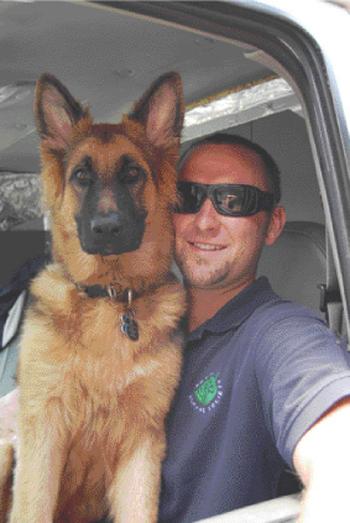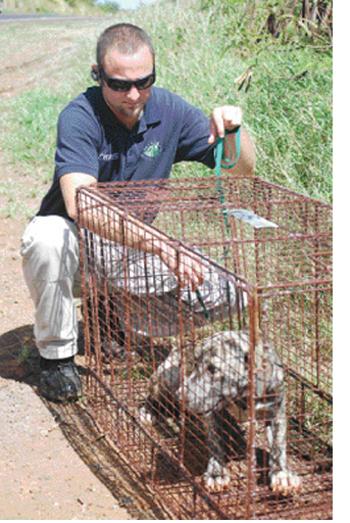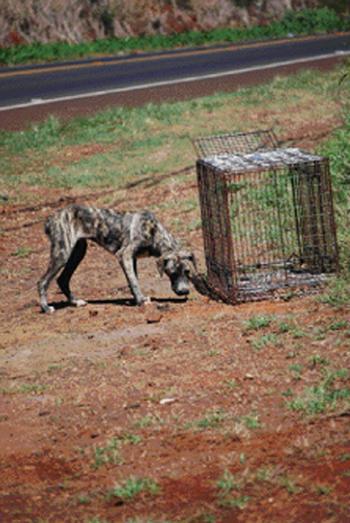PUHI — Whatever he was eating off the hot Hanapepe asphalt, he was intent upon it. A rack of bones with a tawny pelt stretched across it, this hungry hound had clearly been on his own for awhile. Driving west
PUHI — Whatever he was eating off the hot Hanapepe asphalt, he was intent upon it. A rack of bones with a tawny pelt stretched across it, this hungry hound had clearly been on his own for awhile.
Driving west on Kaumuali‘i Highway Officer Chris Vierra, service manager for the Kaua‘i Humane Society, slowed to make a U-turn along side the dog. Opening the van door just five feet from where the brindle stood he called softly, “Hey, there boy.”
Startled, the dog skipped down the highway a few yards before turning to look back at the van.
“It’s very rare to catch a dog racing on the highway,” Vierra said, as he tailed the now trotting stray along the shoulder of the road.
Cars raced by and somewhere between them, the dog crossed to the north side of the road — again pausing to watch the van.
“They usually bolt into the grass,” he said.
But today would be different.
Vierra eased the van to the opposite side of the highway to park a few hundred feet ahead of the dog that was now staring down the road at him. After setting the trap, Vierra drizzled canned dog food gravy 10 feet from the cage, leaving chunks of the wet food to lure him — finishing with more inside the cage.
Within a few minutes he cautiously approached, his hunger outweighing fear. Three more minutes passed and he was in the trap eating. When the door dropped behind him he barely noticed. In fact, he was so docile, I interpreted it as relief, but am sure it was pure exhaustion and starvation that drew him into our grasp.
As part of my ride-along, Vierra and I were on our way for pick-ups on the Westside. A pick-up is when someone finds a dog or traps an animal. The other task that governs the day of a humane society officer — when a citizen calls to report concerns of neglect or abuse — is known as a case.
Three humane officers work around the clock seven days a week at KHS. The two on duty daily split the island in half. On this day Vierra has four stops on the Westside: Two are trapped cats caught by residents and the other two are to set dog traps where one dog is a wounded stray hunkering down near a business and the other a dog creating a nuisance in a neighborhood. The unscheduled stop to rescue the stray was not atypical of most trappings.
“When you can actually get the dog it’s rewarding,” Vierra said. “Some dogs are really smart. They’ll lay by the cage or keep circling it. It can take days to catch a dog or even weeks. Like fishing, you have to keep re-baiting and get tactical.”
While attending to the pick-ups, Vierra’s phone rings regularly with complaints and updates on cases. Calls are prioritized with injured animals and cases of cruelty at the top of the list. The one case we do visit is a report by a neighbor of a dog living in a two-by-two foot kennel. Upon investigation, Vierra finds the dog in a clean, small pen with shelter, food and clean water. After talking to the owner, he decides this is not a case of neglect or abuse.
Vierra encourages people to call when they suspect abuse though. All calls remain confidential whether they leave a name or not.
“We get anonymous calls which make it hard to follow up,” he said. “It’s important for the caller to leave a phone number in case we need to verify details.”
Next we arrive at a house where a resident had trapped 10 cats and stored them in a large dog kennel. Feral is a hygienic way of describing these ragged souls with pussy eyes glued shut from what Vierra calls “an upper respiratory infection that is very contagious.”
With no way to separate them safely to place in individual cages, Vierra uses a dolly to transport this writhing mass of frightened cats into the van. The stink of urine and sickness triggers my gag reflex.
Back in the van, I can smell them through the wall that separates the cab from the holding area for animals. I’m grateful there’s no dead animal pick-ups scheduled so far today.
At another stop there’s a cat in a cage yowling.
“If they’re crying it’s usually someone’s pet,” Vierra said. “The feral ones are quiet — they just hiss and spit.”
Chances are good that this fellow will be noted missing by his owners and returned home in a day or two.
But cats like the ones sharing a cage have their fate sealed — further evidence in support of spaying and neutering pets and trapping the ferals in good health to sterilize and possibly re-release.
What Vierra refers to as his “number one call” is for something he has little control over — noise complaints about barking dogs. Kaua‘i doesn’t have a noise ordinance. Even if there was one it would be hard for officers to impose since most of Kaua‘i is considered agricultural and not residential.
“Tickets won’t solve the problem,” he said. “The best approach is the neighborly one — communicating with each other. KEO offers mediation between neighbors if they need it.”
The problem, he said, is that people don’t want to talk to their neighbors.
Issuing 20 to 30 tickets monthly for violations of the leash law, occasionally Vierra does meet with hostility from the recipient of the ticket. Fortunately KHS has a strong relationship with Kaua‘i Police Department and officers can call at any time for back up.
“I try to work with people and make recommendations,” he said. “I’ll drop a ticket if someone’s willing to put up a runner for their dog. I give them a week.”
When I ask if he’s able to leave his job at work when he goes home at the end of the day, he just shakes his head and says, “No.”
• Pam Woolway, lifestyle writer, can be reached at 245-3681, ext. 257 or pwoolway@kauaipubco.com.




